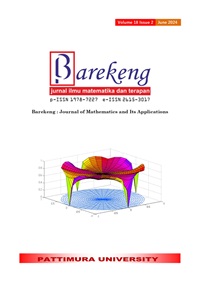ANALYSIS OF RELATIONSHIP BETWEEN THE USAGE OF ONLINE LOAN SERVICES AND THE WELL-BEING OF INDONESIAN USING CHI-SQUARE TEST
Abstract
Online fintech lending offers convenience by providing flexibility for both lenders and borrowers. It led to a significant increase in users. Despite this encouraging growth, it comes with risks, such as the emergence of illegal loan companies. The controversial positive and negative aspects of online loans have sparked the researchers' interest in understanding how the Indonesian public perceives the existence of online loans and whether there is a relationship between the use of online loans and the well-being of users. The data were collected through the questionnaire using Google Form and then distributed to respondents who meet the specified sample criteria, namely Indonesian, aged 17 years old or above, and still able to think rationally. The total study sample are 191 respondents, with the total male is 90 and the total female is 101. Since the results of the data gathered were in the form of categorical data, so the Chi-square test is utilized in this study. With the calculated chi-square less than the chi-square table, it showed that there is no correlation between the frequency of using online loan services and the well-being of the Indonesian people, whether based on age, level of education, or type of job. Hence, it can be concluded that the usage of online loan services is not influences the well-being of Indonesian. It is also known that public perceptions of online loans vary and cannot be generalized. However, those less prosperous, tend to agree with and appreciate the online loan services’ existence compared to those who are prosperous.
Downloads
References
D. R. Andista and R. Susilawaty, “The Influence of Perceived Ease of Use and Risk on Interest in Using Financial Online Loan Technology,” Pros. 12th Ind. Res. Work. Natl. Semin., pp. 1228–1233, 2021, [Online]. Available: https://jurnal.polban.ac.id/proceeding/article/view/2919
D. W. Arner, D. A. Zetzsche, R. P. Buckley, and J. N. Barberis, “FinTech and RegTech Financial Stability,” Georg. J. Int. Aff., vol. 18, no. 3, pp. 47–58, 2017.
U. Prajogo and R. Rusno, “Persepsi risiko terhadap minat melakukan pinjaman online dengan kemudahan penggunaan sebagai variabel moderasi,” MBR (Management Bus. Rev., vol. 6, no. 1, pp. 22–32, 2022, doi: 10.21067/mbr.v6i1.6680.
N. Saadah, “Perencanaan Keuangan Islam Sederhana dalam Bisnis E-Commerce pada Pengguna Online Shop,” Econ. J. Ekon. Islam, vol. 9, no. 1, pp. 105–128, 2018, doi: 10.21580/economica.2018.9.1.2593.
H. Nugroho, “Perlindungan Hukum bagi Para Pihak dalam Transaksi Pinjaman Online,” J. Huk. Positum, vol. 5, no. 1, p. 32, 2020, doi: 10.35706/positum.v5i1.3482.
Y. T. Dkw and I. G. P. D. Awatara, “Swot Analysis of Financial Technology Implementation To Online Peer To Peer (P2P) Lending in Indonesia,” J. Appl. Econ. Dev. Ctries., vol. 3, no. 2, pp. 100–115, 2018, [Online]. Available: https://jurnal.uns.ac.id/jaedc/article/view/40327
E. Kandly Panginan and Irwansyah, “Fenomena Aplikasi Kredit Dan Pinjaman Online Kredivo Di Indonesia,” J. Komun. Dan Kaji. Media, vol. 4, no. 1, pp. 12–26, 2020.
P. A. Salmah, “Pengaruh Persepsi Kemudahan dan Kepercayaan Terhadap Keputusan UMKM Menggunakan Pinjaman Online Dengan Minat Sebagai Variabel Mediasi (Studi Kasus UMKM di Kecamatan Jamblang),” INSTITUT AGAMA ISLAM NEGERI (IAIN) SYEKH NURJATI CIREBON, 2023. [Online]. Available: https://repository.syekhnurjati.ac.id/12411/
F. Alfatih, M. Muqowim, and B. Anggara, “Persepsi Masyarakat tentang Pinjaman Online : Studi Kasus Masyarakat Plaju Kota Palembang Sumatera Selatan,” Islamika, vol. 5, no. 2, pp. 657–668, 2023, doi: 10.36088/islamika.v5i2.3115.
R. Lenz, “Peer-to-Peer Lending: Opportunities and Risks,” Eur. J. Risk Regul., vol. 7, no. 4, pp. 688–700, 2016, doi: https://doi.org/10.1017/S1867299X00010126.
A.-M. Bagnall, “Eleven: Community well-being programmes: reviewing ‘what works,’” pp. 149–164, 2017, doi: https://doi.org/10.51952/9781447336860.ch011.
A. Podger and D. Trewin, Measuring and Promoting Wellbeing: How Important is Economic Growth? Canberra: Australian National University Press, 2014. doi: 10.26530/oapen_477382.
N. Loubere, CYBER LOAN SHARKS, SOCIAL CREDIT, AND NEW FRONTIERS OF DIGITAL CONTROL. Canberra, Australia: ANU Press, 2017. [Online]. Available: https://openresearch-repository.anu.edu.au/handle/1885/219407?mode=full
I. Ghozali, Aplikasi Analisis Multivariete Dengan Program IBM SPSS 23, 8th ed. Semarang: Badan Penerbit Universitas Diponegoro, 2016. [Online]. Available: https://onesearch.id/Record/IOS2851.slims-19545
N. Chamidah, N. R. A. A. Siregar, M. F. Al Farizi, B. S. Pratama, A. Faiza, and M. H. Fibryan, “Categorical Analysis To Perceptions of Government Policy in Electricity Fuel Management As Alternative To Substitute Oil Fuel Using Chi-Square Test,” BAREKENG J. Ilmu Mat. dan Terap., vol. 17, no. 3, pp. 1287–1300, 2023, doi: 10.30598/barekengvol17iss3pp1287-1300.
A. Agresti, AN INTRODUCTION TO CATEGORICAL DATA ANALYSIS, 3rd ed. Florida, United States: Wiley, 2019. [Online]. Available: http://repository.universitasbumigora.ac.id/2217/1861/2019 An Introduction to Categorical Data Analysis by Alan Agresti.pdf
E. Matanda and M. Mawere, Research Methods and Statistics for Cross-Cutting Research: Handbook for Multidisciplinary Research. Bamenda, Cameroon: Langaa Research & Publishing Common Initiative Group, 2022. [Online]. Available: https://books.google.co.id/books?hl=id&lr=&id=JqiTEAAAQBAJ&oi=fnd&pg=PP1&dq=%5D+Matanda,+E.,+%26+Mawere,+M.,+“Descriptive+Statistics+for+Sample+Data.+In+Research+Methods+and+Statistics+for+Cross-Cutting+Research:+Handbook+for+Multidisciplinary+Research&ot
Copyright (c) 2024 Nur Chamidah, Nadhira Safa Kamiilah, Putu Eka Andriani, Cynthia Anggelyn Siburian, Muhammad Rizaldy Baihaqi, Salma Bethari Andjani S

This work is licensed under a Creative Commons Attribution-ShareAlike 4.0 International License.
Authors who publish with this Journal agree to the following terms:
- Author retain copyright and grant the journal right of first publication with the work simultaneously licensed under a creative commons attribution license that allow others to share the work within an acknowledgement of the work’s authorship and initial publication of this journal.
- Authors are able to enter into separate, additional contractual arrangement for the non-exclusive distribution of the journal’s published version of the work (e.g. acknowledgement of its initial publication in this journal).
- Authors are permitted and encouraged to post their work online (e.g. in institutional repositories or on their websites) prior to and during the submission process, as it can lead to productive exchanges, as well as earlier and greater citation of published works.






1.gif)



